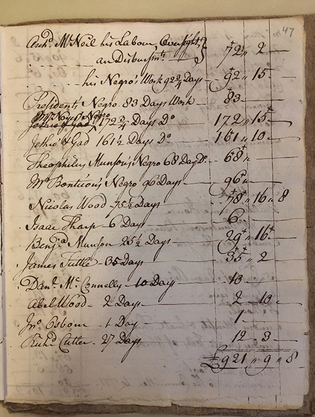
Manuscripts and Archives
Records of the construction of Connecticut Hall (1748–1752) kept by Yale president Thomas Clap list the days worked by enslaved people, including one person held by Clap himself.
View full image
Enslaved people worked on Connecticut Hall
In many stories of early Yale, the work of building Connecticut Hall is credited to two men, Francis Letort and Thomas Bills. The records show that during the construction (1748 to 1752), Letort worked 165 days and Bills 114.75 days. However, in the papers of Yale College president Thomas Clap, we found that a substantial amount of the labor on Connecticut Hall was performed by Jethro and Gad Luke, a father-and-son pair, both free Black men. They worked a total of 191 and a half days, performing tasks such as making mortar.
But Clap’s records also revealed that at least five enslaved men worked on the building. Their time was recorded: a total of 436 and one-half days. Other than one enslaved man called “Mingo,” their names were not. They were listed by the names of their enslavers, with notes like “President’s Negro” and “Mr. Noyes’ Negro.” Their hours, combined with those of Jethro and Gad Luke, represent about 27 percent of the labor that built Connecticut Hall, but these Black men have been ignored in previous histories of Yale.
From Clap’s papers we turned to the university treasurer’s records, and then to probate records, assembly records, newspapers—especially the Connecticut Gazette—and other primary documents to try to uncover the presence, names, and lives of the people who helped build Yale. This is a continuing process that requires cross-referencing names across those various documents to find as much information as possible from very tiny threads. So far, we’ve been able to identify most of the “Negroes” who worked on the building: Jack, enslaved to Joseph Noyes. Dick, enslaved to Theophilus Munson. George, enslaved to President Thomas Clap. And Mingo, enslaved to Arch. McNeil. We are still looking for the name of the man enslaved to a Mr. Bonticou.
We have also identified 16 slave owners who were paid for their contributions, such as building materials, toward the construction of Connecticut Hall. And we’ve found five slave owners who donated to the project. Clearly, there were multiple levels at which slavery was part of the building process for Connecticut Hall.
It isn’t the only Yale project that benefited from slavery. In 1721, when the school moved to New Haven, it finished construction of two buildings: a rector’s house and “a splendid collegiate house.” In that year, the Connecticut Assembly directed taxes from West Indian rum go to the college. The rum was produced in the Caribbean by untold numbers of enslaved Africans, whose lives were routinely endangered and lost during the brutal labor of harvesting and processing sugar cane into sugar, rum, and molasses.
Between 1700 and 1765, the college also took donations from several locals who profited from owning Black and indigenous people. Among them: Rev. Solomon Williams of Lebanon, Jared Ingersoll, Esq., of New Haven, Rev. Samuel Bird of New Haven, and Governor Gurdon Saltonstall. A number of Yale trustees, such as Joseph Noyes and Timothy Woodbridge, owned enslaved people. Even some Yale students owned slaves.
Slavery in the colony, and later the state, of Connecticut began with the enslavement of Native Americans and remained legal until 1848. The first generation of large-scale Native American slavery occurred in the 1600s. Native American slavery paved the way for African slavery, as New Englanders developed laws and practices that affected Africans and Indians alike. In the 1700s, the majority of slaves were Africans or of African descent. Enslaved Africans were purchased both from the coast of Africa and from British-controlled islands in the West Indies, where New England and Connecticut merchants had extensive partnerships. Slave owners in Connecticut generally had just a few slaves, but those enslaved people represented large proportions of their enslavers’ wealth. Several of these enslavers were connected to the development of the college.
In numerous ways throughout the eighteenth century, slavery was a part of the building and development of Yale. Unequivocally, the history of slavery belongs in the history of Yale College. New records of that history, including all the ways free and enslaved people contributed to the institution, are essential for accurate accounts of the past.
Teanu Reid ’23PhD is a doctoral candidate in African American studies and history.
 loading
loading